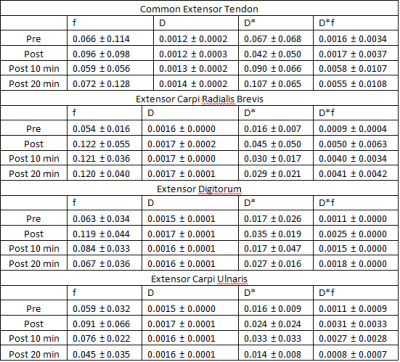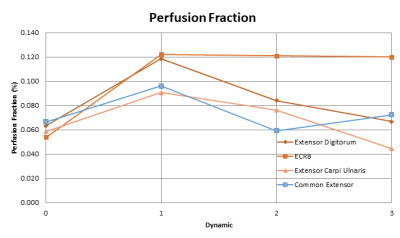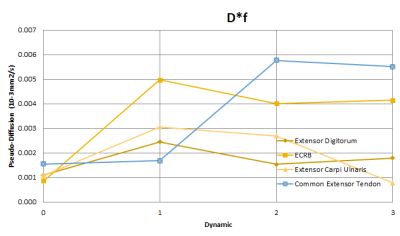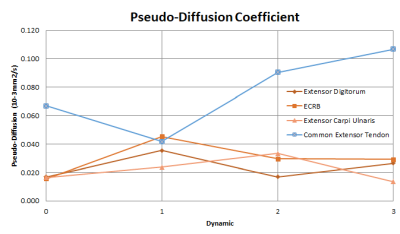Michael Liu1, Patrick Quarterman1, Sachin Jambawalikar1, and Tony Wong1
1Columbia University, New York, NY, United States
Synopsis
Altered perfusion may be a marker of tendon damage. Measurable perfusion characteristics using non contrast techniques such as Intravoxel Incoherent Motion Diffusion Weighted imaging may be a useful technique for assessing perfusion characteristics of tendon.
Abstract
Intravoxel incoherent motion (IVIM) imaging has been proposed as a useful technique for assessing the perfusion and diffusion of muscles. Changes in IVIM parameters (f, D*, and D) are detectable in muscle following exercise. The aim of this work is to determine the selectivity and temporal evolution of f, D*, and D in the muscle-tendon unit following exercise.Background
Altered perfusion may be a marker of muscle and tendon
damage. Therefore, measurement of perfusion may provide useful information in
treatment or diagnosis of various muscle and tendon disease states2, 6.
Intravoxel incoherent motion (IVIM) imaging has been proposed as a useful
technique for assessing the perfusion and diffusion of muscles and tendons with
detectable changes occurring in f, D*, and D parameters 3,6,7. The
aim of this work is to determine the selectivity and temporal evolution of IVIM
parameters in the forearm tendino-musculature following exercise. Methods
Eight volunteers (2 women and 6 men) ranging from the ages
of 28 years to 51 years were scanned on a GE Healthcare 3.0T 70cm bore scanner
(MR750W) using a 16 channel Small Flexible extremity phased array coil. The
subjects were scanned in a lateral decubitus arm down position. Images were
acquired in the axial plane perpendicular to the long axis of the forearm.
An Anatomical T1 weighted fast spin echo (FSE) sequence was
acquired with the following parameters: field of view 16cm x 16cm, Matrix 512 x
256, 26 slices, slice thickness 4mm and 0 gap, TR/TE:614ms/14.5ms, echo train
length 4, receiver bandwidth 50kHz, parallel imaging (ARC) acceleration factor
1.5. Total scan time was 1 minutes 59
seconds.
IVIM EPI sequence
The standard product
spin-echo single shot echo planar imaging (EPI) diffusion weighted (DW) was
performed with the following parameters:
field of view 16cm x 16cm, Matrix 80 x 80, 26 slices, slice thickness
4mm and 0 gap, TR/TE:3500ms/75.3ms, receiver bandwidth 166.7kHz, parallel
imaging (ASSET) acceleration factor 2.
EPI was acquired in 3 orthogonal directions at multiple b-values (0, 10,
20, 40, 80, 110, 140, 170, 200, 300, 400, 500, 600, 700, 800, 900 s/mm2),
averaged 2 times for b-values (0 – 600) and 3 times for b-values (700 – 900).
Total acquisition time was 5 minutes and 43 seconds. This series was conducted
once prior to exercise and three times (0 minute, 10 minutes and 20 minutes)
post exercise
Exercise
The volunteers were taken out of the scanner after the
initial scans of T1 FSE and EPI-DW then seated with forearm in the prone
position to perform a wrist flex maneuver for 2 minutes with a 5-pound
dumbbell. Immediately after exercise, the volunteers were returned to the
scanner in the same scanning position to complete the remaining EPI-DW
scans.
Image Processing
All EPI DW images were deformably registered to the pre
exercise b0 image using Advanced Normalization Toolkit1.. Mutual
information was used as the similarity metric for registration and b-splines
were used for interpolation. ROI’s were drawn on a single slice around the extensor
carpi radialis brevis, extensor digitorum, extensor carpi ulnaris, and the
common extensor tendon using MITK diffusion toolkit4. The IVIM model
was fitted to each ROI with the same software. D and f parameters were
initially fitted to the signal intensities of scans with b values higher than
170. These parameters were then used to fit D*.Results
Diffusion coefficient, pseudo-diffusion coefficient and
perfusion fraction parameters derived from the extensor muscles and tendons are
tabulated in Table 1. Student t-tests demonstrate that the changes in perfusion
parameters in tendon between time points are not statistically significant. Student t-tests amongst parameters derived
from extensor muscles shows D* parameters derived from extensor muscles as well
as perfusion fraction derived from extensor carpi ulnaris are not statistically
significant. Average values of individual muscle groups shows an increase in
perfusion fraction from pre exercise to post exercise values and a decline of
parameters from post exercise to 10 minutes and 20 minutes post exercise.
Tendon perfusion parameters show that there is a trend toward elevated
perfusion parameters following exercise. Conclusion
These results show the possibility of detecting perfusion
changes in tendon with IVIM DW imaging. Though the changes detected in this
experiment are not statistically significant, the trends corroborate physiological
changes that would take place. The results also indicate that perfusion changes
in tendon may evolve temporally differently than perfusion changes in muscle.
As a whole we see that perfusion changes due to exercise are reflected in IVIM
derived perfusion parameters corroborating results from previous papers
indicating IVIM was a viable for detecting perfusion changes in muscle5.Acknowledgements
No acknowledgement found.References
1. Avants BB, Epstein CL, Grossman M, Gee JC. Symmetric
diffeomorphic image registration with cross-correlation: evaluating automated
labeling of elderly and neurodegenerative brain. Med Image Anal. 2008
Feb;12(1):26–41.
2. Challa ST, Hargens AR, Uzosike A, Macias BR: Muscle
Microvascular Blood Flow, Oxygenation, pH, and Perfusion Pressure Decrease in
Simulated Acute Compartment Syndrome. J Bone Joint Surg Am 2017; 99:1453–1459.
3. Filli L, Boss A, Wurnig MC, Kenkel D, Andreisek G, Guggenberger
R: Dynamic intravoxel incoherent motion imaging of skeletal muscle at rest and
after exercise. NMR Biomed 2015; 28:240–246.
4
Fritzsche, Klaus H., Peter F. Neher, Ignaz Reicht, Thomas van Bruggen, Caspar
Goch, Marco Reisert, Marco Nolden, et al. “MITK Diffusion Imaging.” Methods of
Information in Medicine 51, no. 5 (2012): 441.
5 Liu C, Liang C, Liu Z, Zhang S, Huang B. Intravoxel
incoherent motion (IVIM) in evaluation of breast lesions: Comparison with
conventional DWI. European Journal of Radiology [Internet]. 2013 Dec 1 [cited
2017 Nov 9];82(12):e782–9
6. Qi J, Olsen NJ, Price RR, Winston JA, Park JH: Diffusion-weighted
imaging of inflammatory myopathies: polymyositis and dermatomyositis. J Magn
Reson Imaging JMRI 2008; 27:212–217.
7. Nguyen A, Ledoux J-B, Omoumi P, Becce F, Forget J, Federau C:
Selective microvascular muscle perfusion imaging in the shoulder with
intravoxel incoherent motion (IVIM). Magn Reson Imaging 2017; 35:91–97.



